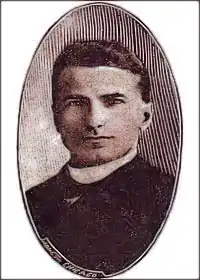Casimir Zeglen
Kazimierz Żegleń (Casimir Zeglen) was a Polish engineer born in 1869 near Tarnopol, (died not before 1927[1]), who invented a silk bulletproof vest.[2] At the age of 18 he entered the Resurrectionist Order in Lwów (today Lviv, Ukraine). In 1890, he moved to the United States.

In 1893, after the assassination of Carter Harrison, Sr., the mayor of Chicago, he worked on an improved silk bulletproof vest. In 1897, he worked on it with Jan Szczepanik. It saved the life of Alfonso XIII, the King of Spain—his carriage was covered with Szczepanik's bulletproof armour when a bomb exploded near it.
He was a Catholic priest of St. Stanislaus Kostka Roman Catholic Church in Chicago, then the largest Polish church in the country, with 40,000 in the parish. In his early twenties, he began experimenting with the cloth, using steel shavings, moss, and hair. In his research, he came upon the work of Dr. George E. Goodfellow, who had written about the bullet-resistive properties of silk.[3]
All early experiments produced an inflexible cloth which was more in the nature of a coat of chainmail. After the assassination of Mayor Carter Harrison, Zeglen renewed his efforts to find a bulletproof material and determined to use silk. In his mid-thirties he discovered a way to weave the silk, to enable it to capture the bullet, while visiting weaving mills in Vienna, Austria and Aachen, Germany.
A 1⁄8 in (3.175 mm) thick, four-ply bulletproof vest produced there was able to protect the wearer from the lower velocity pistol bullets of that era. Zeglen himself submitted to a test in Chicago. He put on a vest of the material and an expert revolver shot fired at the vest at eight paces and not one of the bullets disturbed Zeglen. The weight of the fabric was 1⁄2 lb (0.23 kg) per sq ft (0.093 m²).
c.jpg.webp)
References
- German page on Casimir Zeglen: de:Casimir Zeglen
- Łotysz, Sławomir (October 1, 2014). "Tailored to the Times: The Story of Casimir Zeglen's Silk Bullet-Proof Vest". Arms & Armour. pp. 164–186.
- Edwards, Josh (May 2, 1980). "George Goodfellow's Medical Treatment of Stomach Wounds Became Legendary". The Prescott Courier. pp. 3–5.
- "Three Grades of Fabric", Brooklyn Eagle, October 9, 1902
- Łotysz, Sławomir. "Mnich wynalazca" (Monk-inventor). Polonia (Chicago) Vol. 13, No. 1-2 (2007) pp. 68–71, and Vol. 14, No. 3-4 (2007) pp. 64–67.
- Articles in Nowy Dziennik (a Polish Daily News) published in New York City): Kuloodporny ksiądz (Bulletproof priest), May 5, 2006; Polski ksiądz i Polski Edison (A Polish priest and the Polish Edison), May 13, 2006; Od habitu do opony (From a Religious habit to a tire), May 20, 2006.
External link
- The Monk Who Stopped Bullets with Silk: Inventing the Bulletproof Vest, article from Culture.pl
- BULLETPROOF, podcast episode about Żegleń from Stories From The Eastern West